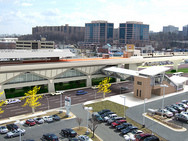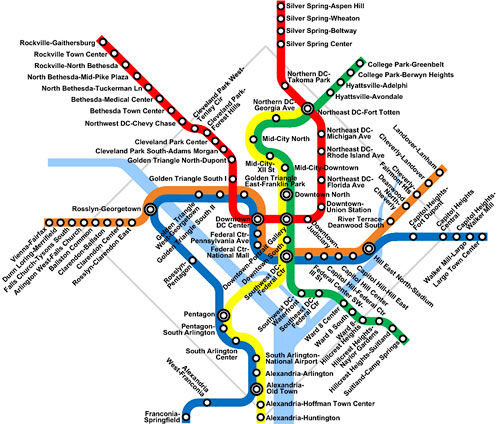Fairfax Silver Line names are boring and repetitive

Photo by fairfaxcounty on Flickr.
Fairfax County’s Board of Supervisors has proposed station names for the Silver Line. But the names are really dull, so they won’t help define neighborhoods, and so repetitive they won’t help riders find their stop.
The Silver Line will bring 8 new Metro stations to Fairfax County. With 5 of those scheduled to open in 2013 and Metro working to create a new map, Fairfax needed to suggest some station names to WMATA.
Unfortunately, their suggestions are mostly bland and unimaginative, and are unlikely to be lend their names to the neighborhoods the line will help to transform. While the WMATA Board has yet to approve these names, they rarely overrule station naming suggestions from one of their jurisdictions.
| Working name | Fairfax proposal |
| Tysons East | Tysons-McLean |
| Tysons Central 123 | Tysons I&II |
| Tysons Central 7 | Tysons Central |
| Tysons West | Tysons-Spring Hill Road |
| Wiehle Avenue | Reston-Wiehle Avenue |
| Reston Parkway | Reston Town Center |
| Herndon-Monroe | Herndon-Reston West |
| Route 28 | Herndon-Dulles East |
The original working names were just placeholders while the line was being designed. They were never intended to become permanent. But Fairfax’s proposal is arguably worse than the placeholders. 8 stations all start with the same 3 words, and there’s little suggesting any kind of sense of place for these areas.
If we’d used Fairfax’s logic in the past, we’d have ended up with something like this:
It’s understandable that Fairfax wants to keep neighborhoods in station names. But places like Tysons and Reston are larger than neighborhoods — they’re more like districts. Tysons itself is larger geographically than downtown DC. Breaking up the Tysons “brand” would help the transforming neighborhoods in Virginia’s largest employment center to define themselves.
And Metro has a history of creating names where they didn’t exist before or at least raising the name-recognition of pre-existing neighborhoods. If Fairfax was truly forward thinking on Tysons, they’d use the Silver Line station names to define unique neighborhoods.
Of course, Metro must also consider wayfinding in the system. That’s seemingly not a big concern for Fairfax. There’s very little repetition in current station naming. Farragut North and Farragut West, originally intended to be one station, both refer to a small square in downtown Washington and are on separate lines. In Arlington, Pentagon and Pentagon City are adjacent stops on the Blue and Yellow Lines.
But Fairfax’s proposal would mean that 4 consecutive stops would start with “Tysons” and the next 3 would include “Reston”. “Herndon” and “Dulles” would each find their way into 2 station names.
The repetitive station names will not only be confusing. They’ll also be misleading. Tysons-McLean is not really in McLean. It just happens to be the closest station to McLean. And the name-chaining makes it sound like most of these stations are in between places, rather than the center of anything.
That’s not helpful for the developers and planners hoping to build communities around these new stops. Is Herndon-Reston West in Herndon or Reston? Surely there’s a neighborhood name that could be appropriated. Even something like “Monroe Street” would be superior.
Also troubling is the inclusion of Roman numerals in one station name. That does not bode well for ease of understanding or readability. As it is, people get confused with “Gallery Pl” which looks like “Gallery PI” in Metro’s sans-serif font.
Each Metro station name should be short and as unique as possible. While Fairfax’s names aren’t so bad on length, their similarity and lack of creativity are just as bad for riders.

